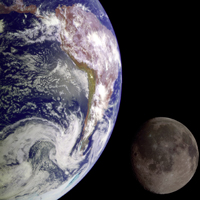What Color is the Moon?
Like any other object, the color of the moon depends on how you look at it. Normally we see the moon as one of the brightest objects in the sky (or at least in its area of the sky) and our visual systems see such unrelated stimuli as either white (like a light bulb) or as a bright color (like signal lights). The facts that the moon reflects all wavelengths of light nearly equally and that we see the moon all by itself and cannot compare it to other similarly illuminated objects means that we cannot see it as any other color than nearly white (sometimes with a little bit of a yellowish tinge).
However, if we were to take the moon and put it next to other objects under the same direct illumination from the sun, we would have a very different perception. The moon would no longer be the only stimulus and it would also not be the brightest stimulus. In fact the surface of the moon only reflects about 12% of the light incident upon it. If we were to compare the moon to a white piece of paper (or an astronaut's white space suit) we would quickly recognize the moon as a dark gray object. In such situations we are viewing the moon as what is known as a related color and we have a more stable perception that is less dependent on the levels and type of illumination. This is illustrated in the composite image above that I constructed based on the measured moon reflectance as well as the direct image taken by the NASA Galileo probe. You can also see it in pictures of astronauts on the moon's surface.
Color perceptions such as gray and brown only exist as related colors (when we can compare them to other similarly illuminated objects). If we see these same stimuli as completely unrelated colors (isolated in a dark environment) then we will instead see white and orange. That is why we can't go to a store and purchase gray, or brown, light bulbs. Another interesting bit of trivia about the color of the moon is that moon dust is retroreflective. That means that, like a road sign, the moon tends to reflect light back in the direction it came from. That explains why the full moon appears fairly uniform in brightness from edge to edge instead of being shaded like a ball would be when illuminated from a single direction (i.e., it looks like a disk, not a sphere).
![]()
Explore the NEXT TOPIC at this level.
Explore the NEXT LEVEL on this topic.
Ever wonder ... Why does the moon look large on the horizon, but this doesn't show up in photographs?
Updated: Dec. 31, 2010

